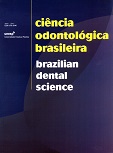Microinfiltração marginal em cavidades preparadas com pontas CVDentUS® e diamantadas convencionais
DOI:
https://doi.org/10.14295/bds.2005.v8i1.235Abstract
O objetivo deste trabalho foi avaliar a microinfiltração marginal em cavidades restritas ao esmalte de dentes bovinos preparados com as pontas CVDentUS® e diamantadas convencionais. Foram realizados preparos cavitários medindo 1mm de profundidade em dois grupos de 15 dentes cada, utilizando ponta diamantada convencional associado à turbina de alta rotação e ponta CVDentUS® associado ao ultra-som. As cavidades foram restauradas com selante para fóssulas e fissuras Fluroshield® (Dentsply) de acordo com as instruções do fabricante. Após serem isolados com Araldite® e esmalte cosmético, os dentes foram submetidos a termociclagem em água a 5°C± 2°C e 55°C± 2°C, totalizando 500 ciclos. Em seguida, foram corados com fucsina básica a 0,5%, seccionados e lixados até ficarem com aproximadamente 0,25mm de espessura, montados em lâminas e identificados. A análise da microinfiltração foi realizada em microscópio óptico ligado a uma câmara digital e conectado a um computador, que permitiu a análise quantitativa da microinfiltração em milímetros por meio de uma imagem digitalizada e um software AxioVision. Os dados obtidos foram submetidos à análise estatística através do teste de Mann-Whitney. Foi observada acentuada microinfiltração marginal em ambos os grupos sem diferença estatistica entre eles (p > 0,05).Downloads
Downloads
Published
How to Cite
Issue
Section
License
Brazilian Dental Science uses the Creative Commons (CC-BY 4.0) license, thus preserving the integrity of articles in an open access environment. The journal allows the author to retain publishing rights without restrictions.
=================




























